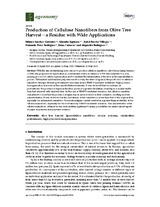Mostrar el registro sencillo del ítem
Production of Cellulose Nanofibers from Olive Tree Harvest—a Residue with Wide Applications
| dc.contributor.author | Sánchez-Gutiérrez, Mónica | |
| dc.contributor.author | Espinosa, E. | |
| dc.contributor.author | Bascón-Villegas, Isabel | |
| dc.contributor.author | Pérez-Rodríguez, Fernando | |
| dc.contributor.author | Carrasco, Elena | |
| dc.contributor.author | Rodríguez, Alejandro | |
| dc.date.accessioned | 2020-05-13T19:12:58Z | |
| dc.date.available | 2020-05-13T19:12:58Z | |
| dc.date.issued | 2020 | |
| dc.identifier.uri | http://hdl.handle.net/10396/19949 | |
| dc.description.abstract | With the aim of identifying new sources to produce cellulose nanofibers, olive tree pruning biomass (OTPB) was proposed for valorization as a sustainable source of cellulose. OTPB was subjected to a soda pulping process for cellulose purification and to facilitate the delamination of the fiber in the nanofibrillation process. Unbleached and bleached pulp were used to study the effect of lignin in the production of cellulose nanofibers through different pretreatments (mechanical and TEMPO-mediated oxidation). High-pressure homogenization was used as the nanofibrillation treatment. It was observed that for mechanical pretreatment, the presence of lignin in the fiber produces a greater fibrillation, resulting in a smaller width than that achieved with bleached fiber. In the case of TEMPO-mediated oxidation, the cellulose nanofiber characteristics show that the presence of lignin has an adverse effect on fiber oxidation, resulting in lower nanofibrillation. It was observed that the crystallinity of the nanofibers is lower than that of the original fiber, especially for unbleached nanofibers. The residual lignin content resulted in a greater thermal stability of the cellulose nanofibers, especially for those obtained by TEMPO-mediated oxidation. The characteristics of the cellulose nanofibers obtained in this work identify a gateway to many possibilities for reinforcement agents in paper suspension and polymeric matrices. | es_ES |
| dc.format.mimetype | application/pdf | es_ES |
| dc.language.iso | eng | es_ES |
| dc.publisher | MDPI | es_ES |
| dc.rights | https://creativecommons.org/licenses/by/4.0/ | es_ES |
| dc.source | Agronomy 10(5), 696 (2020) | es_ES |
| dc.subject | Olive tree harvest | es_ES |
| dc.subject | Lignocellulose nanofibers | es_ES |
| dc.subject | Circular economy | es_ES |
| dc.subject | Valorization | es_ES |
| dc.subject | Pretreatments | es_ES |
| dc.subject | High-pressure homogenization | es_ES |
| dc.title | Production of Cellulose Nanofibers from Olive Tree Harvest—a Residue with Wide Applications | es_ES |
| dc.type | info:eu-repo/semantics/article | es_ES |
| dc.relation.publisherversion | http://dx.doi.org/10.3390/agronomy10050696 | es_ES |
| dc.relation.projectID | Gobierno de España. CTQ2016-78729-R | es_ES |
| dc.rights.accessRights | info:eu-repo/semantics/openAccess | es_ES |

